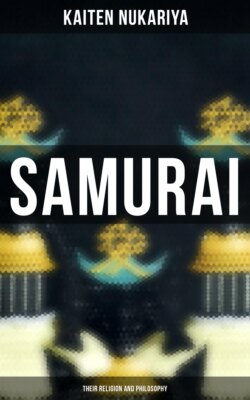Читать книгу Samurai: Their Religion and Philosophy - Kaiten Nukariya - Страница 17
На сайте Литреса книга снята с продажи.
13. The Disciples under the Sixth Patriarch.
ОглавлениеSome time after this the Sixth Patriarch settled himself down at the Pao Lin Monastery, better known as Tsao Ki Shan (So-kei-zan), in Shao Cheu, and it grow into a great centre of Zen in the Southern States. Under his instruction many eminent Zen masters qualified themselves as Leaders of the Three Worlds. He did not give the patriarchal symbol, the Kachaya, to his successors, lest it might cause needless quarrels among the brethren, as was experienced by himself. He only gave sanction to his disciples who attained to Enlightenment, and allowed them to teach Zen in a manner best suited to their own personalities. For instance, Huen Kioh (Gen-kaku), a scholar of the Tien Tai doctrine,47 well known as the Teacher of Yung Kia48 (Yo-ka), received a sanction for his spiritual attainment after exchanging a few words with the master in their first interview, and was at once acknowledged as a Zen teacher. When he reached the zenith of his fame, he was presented with a crystal bowl together with rich gifts by the Empress Tseh Tien; and it was in A.D. 705 that the Emperor Chung Tsung invited him in vain to proceed to the palace, since the latter followed the example of the Fourth Patriarch.
After the death49 of the Sixth Patriarch (A.D. 713), the Southern Zen was divided into two schools, one being represented by Tsing Yuen (Sei-gen), the other by Nan Yoh (Nan-gaku.) Out of these two main schools soon developed the five50 branches of Zen, and the faith made a splendid progress. After Tsing Yuen and Nan Yoh, one of the junior disciples of the Sixth Patriarch, Hwui Chung (E-chu), held an honourable position for sixteen years as the spiritual adviser to the Emperor Suh Tsung (A.D. 756762) and to the Emperor Tai Tsung (A.D. 763-779). These two Emperors were enthusiastic admirers of Zen, and ordered several times the Kachaya of Bodhidharma to be brought into the palace from the Pao Lin Monastery that they might do proper homage to it. Within some one hundred and thirty years after the Sixth Patriarch, Zen gained so great influence among higher classes that at the time of the Emperor Suen Tsung (A.D. 847-859) both the Emperor and his Prime Minister, Pei Hiu, were noted for the practice of Zen. It may be said that Zen had its golden age, beginning with the reign of the Emperor Suh Tsung, of the Tang dynasty, until the reign of the Emperor Hiao Tsung (1163-1189), who was the greatest patron of Buddhism in the Southern Sung dynasty. To this age belong almost all the greatest Zen scholars51 of China.
To the period of the Five Dynasties (A.D. 907-959) belong such teachers as Sueh Fung (Set-po, died in. 908); Huen Sha (Gen-sha, died in 908); Yun Man (Un-mon, died in 949), the founder of the Yun Man Sect; Shen Yueh (Zen-getsu, died in 912), a renowned Zen poet; Pu Tai (Ho-tei, died in 916), well known for his peculiarities; Chang King (Cho-kei, died in 932); Nan Yuen (Nan-in, died in 952); Pao Yen (Ho-gen, died in 958), the founder of the Pao Yen Sect. During the Sung dynasty (A.D. 960-1126) appeared such teachers as Yang Ki (Yo-gi, died in 1049), the founder of the Yang Ki School of Zen; Sueh Teu (Set-cho, died in 1052), noted for poetical works; Hwang Lung (O ryu, died in 1069), the founder of the Hwang Lung School of Zen; Hwang Lin (Ko-rin, died in 987); Tsz Ming (Ji-myo, died in 1040); Teu Tsy (To-shi, died in 1083); Fu Yun (Fu-yo, died in 1118); Wu Tsu (Go-so, died in 1104); Yung Ming (Yo-myo, died in 975), the author of Tsung King Luh (Shu-kyo-roku); Ki Sung (Kai-su, died in 1071), a great Zen historian and author. In the Southern Sung dynasty (A.D. 1127-1279) flourished such masters as Yuen Wu (En-go, died in 1135), the author of Pik Yen Tsih (Heki-gan-shu); Chan Hieh (Shin-ketsu, flourished in 1151); Hung Chi (Wan-shi, died in 1157), famous for his poetical works; Ta Hwui (Dai-e, died in 1163), a noted disciple of Yuen Wu; Wan Sung (Ban-sho), flourished in 1193-1197), the author of Tsung Yun Luh (Sho-yo-roku); Ju Tsing (Nyo-jo), died in 1228), the teacher to Do-gen, or the founder of the So-to Sect in Japan.
To this age belong almost all the eminent men of letters,52 statesmen, warriors, and artists who were known as the practisers of Zen. To this age belongs the production of almost all Zen books,53 doctrinal and historical.
